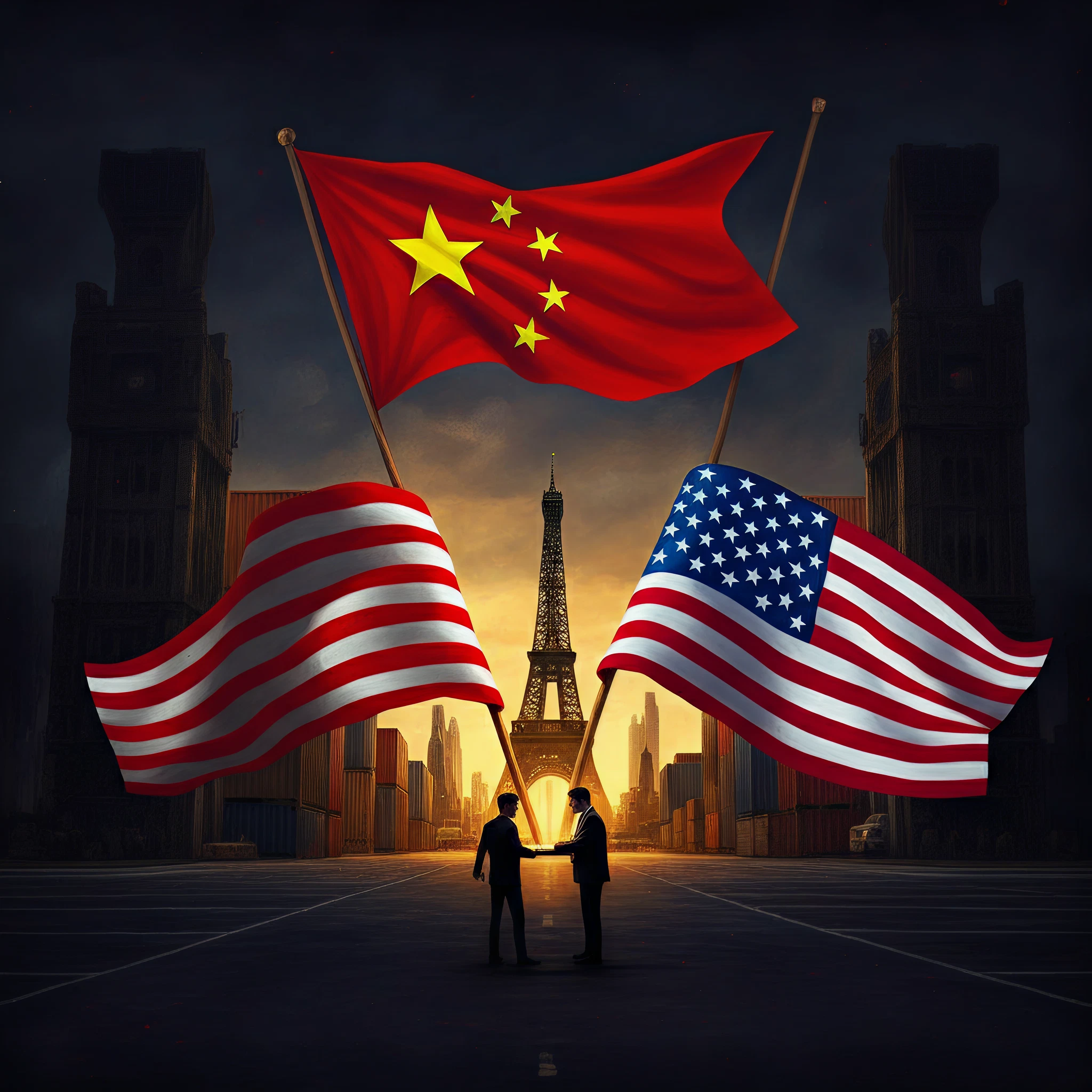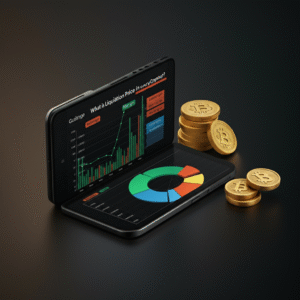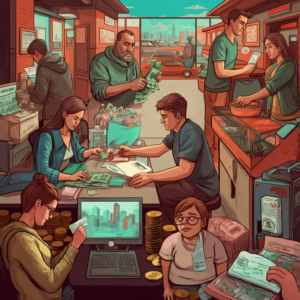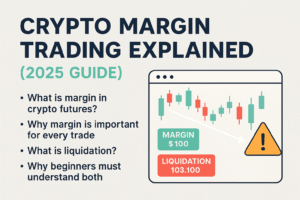The world’s two largest economies, the United States and China, have long held a complex and tumultuous trade relationship.
Since the initial imposition of tariffs during the height of the trade war in 2018, tensions have periodically flared, resulting in significant ripple effects across global markets. Now, in April 2025, the trade war has escalated once again with a new wave of U.S.-China tariffs. These measures, coupled with strained economic conditions, have triggered widespread concerns about their impact not only on these two powerhouse economies but also on global trade.
This article provides a detailed exploration of the newly imposed tariffs, their rationale, and the consequences for businesses and consumers alike. You’ll also find strategies and insights from experts on how to adapt to the changing trade landscape and what the future may hold for U.S.-China relations.
Background
The U.S.-China trade war has its roots in a growing economic rivalry. The initial U.S. tariffs implemented in 2018 targeted Chinese steel and aluminum imports, citing unfair trade practices, intellectual property theft, and a trade deficit. China retaliated with its own tariffs, igniting a tit-for-tat escalation.
Heading into 2025, global economic conditions have been fragile, with slow post-pandemic recovery, inflationary pressures, and disruptions in supply chains still reverberating. The U.S. administration’s latest move to announce higher tariffs on Chinese imports comes amid growing concerns over protecting domestic industries and addressing national security risks tied to technological competition.
Impact on Global Trade
The increased tariffs between the U.S. and China have sent ripples across the global trade landscape. Countries reliant on these economic powerhouses for both imports and exports face heightened uncertainty. Supply chains have been forced to adapt as businesses look for alternative markets and routes to mitigate rising costs. Smaller economies, in particular, have struggled to cope with the ripple effects, leading to economic slowdowns in certain regions.
Implications for Domestic Industries
For domestic industries in the U.S., the tariffs bring both opportunities and challenges. Sectors such as manufacturing and technology may benefit from reduced competition with Chinese imports, potentially boosting local production. However, reliance on imported raw materials and components has led to increased costs for many businesses, putting pressure on profit margins and consumer prices. Balancing these outcomes remains a complex policy challenge.
Technological Rivalry
The escalation in tariffs underscores the strategic competition between the U.S. and China in technology. Issues such as intellectual property theft and dominance in critical sectors, including semiconductors and artificial intelligence, remain central to the conflict. By imposing tariffs, the U.S. aims to curb dependency on Chinese tech and foster innovation domestically, while China continues to accelerate its ambitions for technological self-sufficiency. This rivalry has far-reaching implications for global technological advancement and security.
Specific Tariffs Imposed
The April 2025 escalation introduces an array of new tariffs aimed at curbing China’s economic influence. Key measures include:
- 25% tariffs on semiconductors and electronics such as smartphones and laptops, citing concerns over technological dependencies.
- 30% tariffs on solar panels and green energy equipment, aimed at bolstering U.S. manufacturing capacity in renewable technologies.
- 20% tariffs on consumer goods including apparel, footwear, and household items.
- Additional taxes on machinery and industrial goods to further protect U.S. manufacturers.
The rationale provided by U.S. officials points to national security concerns, a widening trade gap, and an effort to encourage domestic production in strategic industries.
Current Situation Regarding Tariffs
Trade Relations and Global Impacts
The ongoing tariffs have created significant ripples across global trade networks. Many international partners have raised concerns about the rising costs of goods and the potential for retaliatory measures. This has led to trade tensions and diplomatic negotiations aimed at finding common ground.
Economic Outcomes for Domestic Industries
Domestically, while some industries, such as steel and renewable energy manufacturing, have reported growth due to protective tariffs, others reliant on imported raw materials have faced increased production costs. This has caused price hikes and strained supply chains in several sectors.
Consumer Impact
For everyday consumers, the higher tariffs on goods like apparel and household items have translated to increased retail prices. This has further burdened households already grappling with inflationary pressures, affecting overall purchasing power.
Ongoing Negotiations
Despite these challenges, talks are underway with key trading partners to reassess current tariffs and potentially strike new trade agreements. Policymakers are working to strike a balance between protecting domestic industries and minimizing negative economic consequences.

Impact on the U.S. Economy
The immediate consequences for the U.S. economy are a double-edged sword. On the one hand, higher tariffs on key imports may push consumers to explore domestically produced goods, fostering growth in U.S. manufacturing and reducing reliance on foreign suppliers. However, the downside is that tariffs essentially function as a tax that businesses pass on to consumers, leading to higher prices for everyday goods.
Affected Industries
- Electronics & Technology: U.S.-based tech companies relying on Chinese-manufactured components may face rising costs, eroding profit margins and potentially delaying innovation.
- Renewable Energy: Tariffs on solar panels could slow the growth of green infrastructure projects, an area the U.S. is keen to expand.
- Consumer Goods: American consumers can expect to pay more for clothing, household items, and electronics, tightening household budgets.
Overall Economic Growth
Economic analysts estimate that these tariffs could dampen GDP growth by 0.2–0.4% in the coming fiscal year while exacerbating inflationary pressures. Small businesses and startups that lack the resources to adapt to supply chain disruptions may be particularly vulnerable.
Impact on the Chinese Economy
China, heavily reliant on export-driven growth, is not immune to the consequences of escalated tariffs. Tariffs targeting high-tech goods and renewable technologies have hit key industries central to China’s economic strategy.
Consequences on Businesses and Employment
- Decreased Exports: Chinese exports to the U.S. are expected to decline sharply, reducing income for major manufacturing hubs in provinces like Guangdong and Jiangsu.
- Job Losses: Employment rates in export-dependent industries may face pressure as factories grapple with lower demand and increased operational costs.
- Trade Balance: Analysts predict a widening trade imbalance as China looks for alternative markets to offset reduced U.S. trade volumes.
Government Response
China’s government is likely to respond by implementing additional subsidies for domestic industries, diversifying trade partnerships, and increasing retaliatory tariffs on U.S. agricultural goods and machinery, among other products. This could lead to further trade tensions and economic uncertainty for both countries. Additionally, the Chinese government may also implement new regulations or restrictions on foreign companies operating within China as a form of retaliation.
Impact on Global Supply Chains
The ongoing trade tensions between the U.S. and China are expected to cause significant disruptions in global supply chains. Companies that rely on Chinese manufacturing may experience delays, increased production costs, and uncertainty in sourcing materials. This could prompt businesses to consider diversifying their supply chains to mitigate risks, potentially shifting production to other countries in Southeast Asia or beyond.
Effects on Consumer Prices
The escalation of tariffs and trade barriers is likely to result in higher costs for imported goods, which can directly impact consumer prices. Products such as electronics, clothing, and household items that are heavily reliant on Chinese manufacturing may see price increases in international markets. For consumers, this can mean reduced purchasing power and potential changes in spending habits as they adapt to the higher costs.
- Impact on Global Economy: The ongoing trade war between the U.S. and China has significant implications for the global economy. As two of the largest economies in the world, their actions can have ripple effects on other countries and industries around the globe. The uncertainty and disruptions caused by this trade war may slow down economic growth and hinder international trade.

Global Implications
The shielding of domestic industries through tariffs does not happen in isolation. The global economy is deeply interconnected, and the U.S.-China tariffs have ripple effects well beyond their borders.
Disruptions in Global Supply Chains
The integration of global supply chains has been a major driver of economic growth and efficiency. Companies have set up complex networks of suppliers and manufacturers around the world to take advantage of lower costs and specialized skills. However, the trade war has disrupted this interconnected system, causing delays and increasing costs for companies that rely on Chinese goods.
Impact on Other Countries
The U.S.-China trade war does not only affect these two countries directly involved, but also impacts other countries that are heavily dependent on trade with them. For instance, China is an important trading partner for many developing countries, providing them with cheap imports and investment opportunities. With China’s economy slowing down due to the trade war, these developing countries are also feeling the effects.
Moreover, as the trade war continues, there is a possibility of a global economic slowdown. This could be detrimental for countries that heavily rely on exporting goods and services to China and the U.S. As tensions between the two nations escalate, other countries may also face pressure to choose sides or make difficult decisions about their own trade policies.
International Trade and Supply Chains
Key industries dependent on global supply chains, such as electronics and automotive, are already feeling the strain. Countries heavily reliant on trade with China and the U.S.—like Germany, Japan, and South Korea—must now recalibrate their supply chain strategies. Emerging economies in Southeast Asia may benefit, as companies explore alternatives to sourcing from China.
Technology and Innovation Amid Trade Conflicts
Trade tensions have spurred innovation in various markets as countries and companies seek technological independence. The semiconductor industry, in particular, has been heavily impacted, with nations like the U.S. investing in domestic chip production to reduce reliance on foreign suppliers. Additionally, China has accelerated its research and development in artificial intelligence and renewable energy technologies to bolster its self-reliance. This shift has created opportunities for startups and established companies to lead in cutting-edge technological advancements.
Environmental Considerations in Trade Policy
Environmental factors are increasingly influencing trade decisions worldwide. With the global focus on reducing carbon emissions and combating climate change, governments are prioritizing sustainable supply chain practices. Green trade agreements and carbon border taxes are becoming critical tools to align economic policies with environmental goals. This shift adds new layers of complexity to global trade dynamics, requiring countries to work toward innovative solutions for achieving both economic and environmental objectives.
The Role of Regional Trade Agreements
Regional trade agreements are playing a growing role in mitigating the effects of global trade tensions. Efforts like the Comprehensive and Progressive Agreement for Trans-Pacific Partnership (CPTPP) and the Regional Comprehensive Economic Partnership (RCEP) have allowed member nations to foster stronger economic ties, providing a counterbalance to the uncertainties posed by U.S.-China relations. These agreements not only enhance trade within specific regions but also create a framework for strategic partnerships that could shape the future of the global economy.
The Role of Technology
As global supply chains become more complex and interdependent, technology has played a crucial role in managing these networks. From tracking shipments to optimizing routes, technology has enabled businesses to streamline their processes and improve efficiency. However, with the unpredictability of international trade policies, technology may need to adapt quickly to changing circumstances
Rising Tensions in Global Trade
The tariffs risk destabilizing international trade norms, fueling protectionism, and complicating negotiations within organizations like the World Trade Organization (WTO). These factors could slow economic recovery worldwide.

Expert Opinions
Economists and trade analysts are divided. Here’s what some key voices are saying:
- Dr. Emily Park, Trade Economist: “The latest tariffs signal a shift from globalization toward economic nationalism, but the long-term cost may be a fragmented global economy.”
- Michael Chen, CEO of GlobalTrade Insights: “Businesses must innovate rapidly to diversify supply chains and reduce reliance on either economy.”
- Sara Martinez, Industry Analyst: “Affected industries can turn these challenges into opportunities by investing in automation and regional trade agreements.”
The Impact on Consumer Goods Prices
Rising tariffs have a direct effect on the cost of consumer goods, causing prices to climb as businesses pass on the added expense to customers. This can lead to reduced purchasing power for consumers and disrupt spending patterns, particularly in industries heavily reliant on international imports.
Strategies for Businesses
To manage the effects of economic shifts, businesses are increasingly focusing on resilience and adaptability. Strategies such as adopting advanced technologies, diversifying suppliers, and forging regional trade partnerships are becoming essential to remain competitive in a fluctuating global market.
Strategies for Businesses
Navigating the impact of these tariffs is crucial for businesses to sustain operations and remain competitive. Here are practical strategies for adapting:
- Diversify Supply Chains: Explore alternate sourcing from countries outside the U.S. and China, such as Vietnam, Mexico, or India.
- Invest in Technology: Leverage automation and AI to streamline operations and reduce reliance on manual labor in regions affected by tariffs.
- Negotiate with Suppliers: Work with suppliers to share tariff costs or lengthen payment terms to alleviate short-term financial strain.
- Focus on New Markets: Develop strategies to expand into less affected regions, enabling growth despite the constraints imposed by tariffs.

Long-Term Outlook
The future of U.S.-China trade relations remains uncertain, with potential scenarios ranging from renewed negotiations and reductions in tariffs to prolonged hostilities and deeper economic decoupling. Businesses should prepare for continued volatility by prioritizing flexibility in their operations and staying informed about trade developments.
Current Trade Statistics
As of recent data, the U.S.-China trade relationship remains one of the largest bilateral trade partnerships in the world. Despite ongoing tensions, total trade in goods and services between the two nations surpassed $700 billion in the last year. Key U.S. exports to China include agricultural products, semiconductors, and aerospace equipment, while China continues to export electronics, machinery, and consumer goods to the U.S. However, the growing imposition of tariffs and restrictions has slightly dampened the volume of trade, encouraging both nations to seek alternative markets and supply chain strategies.
Impact of Tariffs on Global Trade
The ongoing tariff disputes between the United States and China have created ripple effects across the global economy. Higher tariffs on key goods have not only increased costs for businesses but also for consumers, impacting everything from raw materials to finished products. Many multinational companies have been forced to reevaluate their supply chains, often shifting manufacturing operations to other countries in Southeast Asia or elsewhere to mitigate the rising costs.
Technological Decoupling
Another crucial aspect of U.S.-China relations is the growing effort to decouple in the realm of technology. Both nations have invested heavily in securing technological autonomy, particularly in critical sectors such as semiconductors and telecommunications. This divergence is affecting global innovation as new technological alliances and competing standards emerge, potentially reshaping how industries operate globally for decades to come.
Future Outlook
Despite the challenges, there are signs that both countries remain committed to maintaining some level of economic cooperation. Diplomatic channels continue to engage, with occasional talks aimed at reducing trade barriers and fostering a more stable economic relationship. The trajectory of U.S.-China trade relations will likely depend on broader geopolitical developments and how effectively both sides can balance competition with collaboration in the years ahead.
Conclusion
Navigating a rapidly changing global economy requires businesses and professionals to remain adaptable, innovative, and informed. By leveraging technology, diversifying strategies, and staying aware of economic shifts, companies can build resilience and achieve long-term success. The ability to anticipate change and respond strategically is what will differentiate leaders from the rest in this evolving landscape.
FAQs
1. What is strategic planning in a global economy?
Strategic planning in a global economy involves preparing businesses to adapt to economic changes, leveraging international markets, and incorporating innovative solutions to ensure long-term success.
2. How can technology help businesses in a changing economy?
Technology helps businesses streamline operations, reach new markets, enhance productivity, and adopt data-driven strategies, enabling them to stay competitive amidst economic shifts.
3. Why is market diversification important?
Market diversification helps businesses reduce dependency on a single market or region, spreading risks and creating opportunities for growth in different areas.
4. How can professionals stay informed about economic changes?
Professionals can stay informed by following credible news sources, attending industry events, participating in professional networks, and continually upskilling themselves.
5. What role does innovation play in adapting to economic changes?
Innovation allows businesses to develop new products, services, and processes, helping them stay ahead of competition and meet evolving consumer needs.
6. What are some key challenges in managing global supply chains?
Key challenges include fluctuating demand, geopolitical tensions, compliance with international regulations, and disruptions caused by natural disasters or pandemics.
7. How can small businesses compete in a global economy?
Small businesses can compete by focusing on niche markets, leveraging digital tools, offering personalized services, and building strong community relationships.
8. What is the future outlook for businesses in a global economy?
The future favors businesses that are agile, proactive, and driven by data and sustainability initiatives. Companies that understand evolving consumer preferences and act strategically will thrive.









